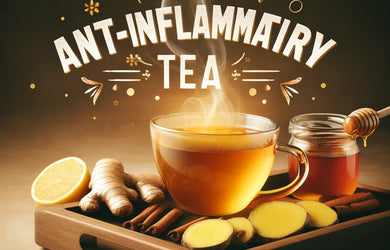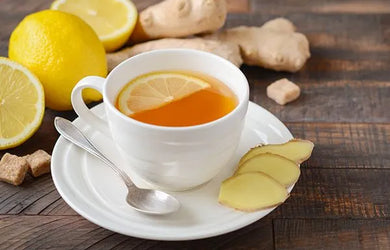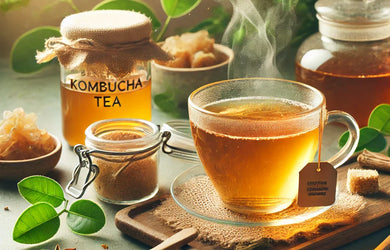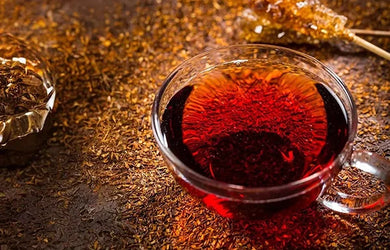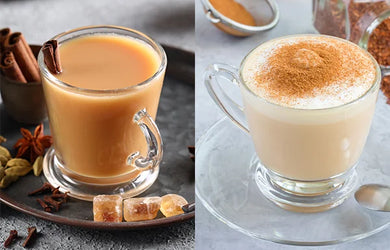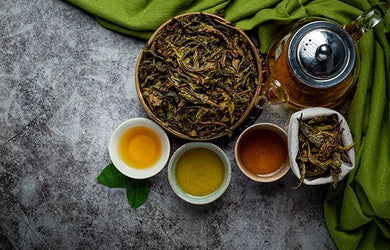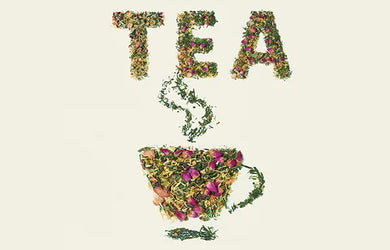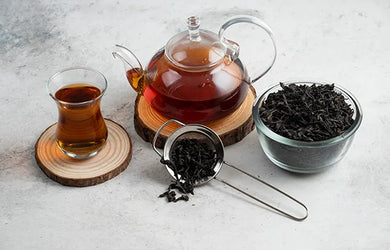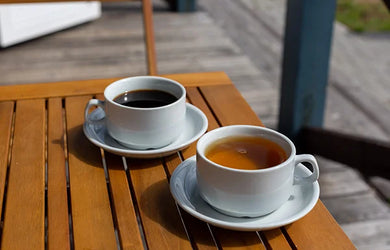Introduction to oolong tea
Black dragon, dark dragon or Wu-long – they all mean the same. Even though the names might not immediately suggest something delicious, they're all referring to the same gorgeous oolong tea.
Fascinating names, right? But there’s a lot more to know about this tea than just its names. And that’s exactly what we’re set to do here! So, if you’ve ever had questions like “What is oolong tea?” or “What is its origin?”, now is the time to get the answers.
Let’s start with the second question first – the origin of oolong is linked to several theories. According to one, it originated in the Wuyi Mountains in Fujian (China) and as per another, it originated in Anxi.
Well, there are no records for that, but we know for sure that it gained massive popularity during the Qing dynasty. By around 1906, it had surged further, leading to the start of its production in Taiwan.

What is oolong tea?
Oolong tea fits right in with the traditional tea family, alongside its well-known members – black and green tea. Just like the others from the family, it's sourced from the Camellia sinensis plant.
That’s where the similarities end, and differences begin! The two main areas of distinction are oxidation level and the shape of the leaves.
Oxidisation of tea leaves: Oolong is positioned between black and green tea on the oxidation spectrum as it’s partially oxidised. Not clear? Let’s touch upon the oxidation process of black and green tea to better understand oolong’s oxidation level.
Black tea undergoes full oxidation during processing, resulting in its dark colour and strong flavour. In contrast, green tea gets minimal oxidation, retaining its original green colour and fresh vegetal taste.
Oolongs, however, fall between these two extremes, undergoing partial oxidation. The degree of oxidation in oolong can vary widely (usually goes up to 85%, but can be higher in some cases), depending on the techniques employed by the tea master.
That means the flavour of these teas can range from crisp and green to malty and robust, reflecting the oxidation level.
Shape of tea leaves: Oolong teas are typically crafted into distinctive shapes, such as tight balls, twisted strands or curled leaves. These shapes are achieved through various rolling techniques, which play a crucial role in the appearance, colour and aroma of the final product.
The process of rolling allows the tea master to manipulate the tea leaves, influencing their flavour development. Depending on when and how the rolling is performed during processing, the tea master can subtly transform the flavours of the tea as needed.

Types of oolong tea
Oolongs come in all sorts of varieties – from green with floral or fruity notes to dark with rich and toasty notes. They can vary widely based on how much they're oxidised and roasted. They also have regional differences.
Light or green oolongs are the least oxidised and lightly roasted teas. Also known as jade oolongs, they look like green tea but have a slightly darker colour. Additionally, they’re usually twisted or rolled into ball shapes.
Some popular ones in this category include Bao Zhong, Lishan and Jin Xuan. Taiwan produces some of these exceptional varieties with natural sweetness and delicate flavours.
Medium-processed oolongs are moderately oxidised with medium roasting. When you up the processing, the profile of the green oolong variety changes to spicier notes with a mellow body and toasty flavours.
Some of the popular ones include Dong Ding (or Tung Ting), Oriental Beauty and Phoenix Dan Cong.
Dark oolongs are processed a bit like black tea. When you brew some, you'll get a full-bodied infusion with subtle flavours of sesame or toasted grain.
Some of the popular ones include Da Hong Pao, Roi Gui and Bai Hao.
If you're on the lookout for oolongs in Australia, you can easily find good quality varieties like Da Hong Pao, Oriental Beauty and Dong Ding.
Oolong tea production process
Plucking the tea leaves. Big and sturdy leaves from older plants are picked so they can handle all the steps of the processing.
Withering the leaves. The plucked leaves undergo bruising through tossing or shaking to kickstart the oxidation process. They're then sun-dried for hours to wither and lose up to 30% moisture. This softens the leaves and ensures they have the required flexibility for the rolling and shaping stages.
Rolling of the leaves. During the rolling process, this tea’s leaves begin to get their distinctive appearance and flavour. They also get more oxygen which boosts their oxidation and flavour.
The wilted leaves get a bit more bruised when they are rolled. This breaks their cell walls to release essential oils – crucial for flavour development.
Now, there are several ways of rolling, depending on the type of oolong. They can be rolled by hand and then tossed in baskets or tightly wrapped in cloth and fired multiple times, like with Tie Guan Yin oolong tea.
Oxidation of leaves. When those leaves react with oxygen, they transform – they start browning and getting darker as time goes on. This change impacts their flavour too!
Now, green and white teas are barely oxidised, and black tea goes all the way, but oolongs are somewhere in the middle – partially oxidised!
Oolongs with minimal oxidation resemble green tea and have a fresh and vegetal flavour with floral or fruity undertones, while the highly oxidised varieties resemble black tea with darker colours and stronger flavours.
Roasting the leaves. Once the tea leaves reach the required level of oxidation, it's time for a little heat treatment to stop further oxidation.
Drying and sorting. After shaping the leaves, they are baked over wood or charcoal to remove the moisture and add complexity to the flavour. After drying, they're sorted visually by size and colour for packaging.
Brewing oolong tea
Due to the wide variation in oxidation levels and processing techniques among the oolong varieties, the brewing techniques can differ. Here's a handy guide to get you started:
Water selection. Start with fresh, pure and cold filtered water.
Steeping temperature and time. Depending on the oolong being used, there can be variations in the recommended temperature. Usually, they are steeped at anywhere between 80°C and 94°C for 1 to 4 minutes. However, you can always adjust steeping time and temperature.
If you don't have a thermometer handy, simply boil the water and then allow it to cool for about 2 minutes before steeping. Just remember, though, that oolongs with minimal oxidation levels call for lower brewing temperatures.
Strain and serve. Once the tea is ready, discard the tea bags or strain the tea if loose leaves were used and enjoy.
Cracking the code. You can tell how much an oolong’s leaves have been roasted by checking out the wet leaves after brewing. If they're bright green, they’re likely lightly roasted. If they're dark green or brownish, that's a medium roast. And if they're dark brown, they’ve probably been roasted quite a bit.
Brewing oolong leaves is easy – just keep these key points in mind.
Avoid over-steeping. Taste your tea after the recommended steeping time and decide if it needs additional steeping. Avoid over-steeping to prevent bitterness. After all, what is oolong tea without its elegant finish?
Check the ratios. Use the guidelines provided with the tea, but usually, around 1 teaspoon (approx. 2 grams) of loose tea leaves (or 1 tea bag) per cup (about 240 ml) of water is the way to go.
Multiple infusions. Most oolong varieties are created for multiple steeping. So, you can enjoy different layers of flavour with each brew. The top-notch ones can even give you 3 to 5 rounds of enjoyment!
What sets oolong tea apart?
Oolong tea has a lovely, flowery scent that's hard to miss. Its taste is truly one-of-a-kind, ranging from subtly sweet and fruity to a bit nutty. What makes this tea special is its variety.
Because of the different levels of oxidation and roasting that this tea goes through, its flavour range is broad. Some types have floral smells with fruity tastes, and some even have nutty flavours.
The terroir or the specific location where tea is grown also affects its flavour. Factors like soil pH, elevation of the area, its slope, rainfall and sunlight exposure – all play a role. Additionally, each tea master adds their unique touch while creating the oolongs.
Some of the interesting flavours are:
- Floral aroma and flavours of peach, jasmine, orchids and other flowers are commonly found in various oolong varieties. Oolongs like Tung Ting and Da Hang Pao are known for their floral scent and taste, without added flavourings.
- Nutty notes can also be found in various oolongs – for example, Dan Cong has a bit of creamy raw almond notes.
- Milky flavour and creamy texture are noticeable in certain varieties of the tea, like Jin Xuan (Milk Oolong) and Gui Fei (Concubine Oolong).
Conclusion
We've only scratched the surface of the incredible variety and complexity that oolongs offer. Every aspect of this tea is packed with fascinating details, inviting an ongoing learning experience to uncover the true essence of what is oolong tea.
While we’ve touched upon the areas of its cultivation, it becomes even more fascinating as one begins to understand the significance of terroir and how tea masters in each region employ their skills to create intriguing variations of oolong.
Now that you’ve taken a step in that direction, we encourage you to explore further and enjoy the rich flavours of this remarkable tea.
FAQs on oolong tea
q. how is oolong tea different from green and black tea?
a. oolong tea differs from green and black tea in its oxidation level. while green tea is unoxidised and black tea is fully oxidised, oolong falls in between – it’s partially oxidised. due to partial oxidation, it has distinct flavours which range from floral and fruity to rich and toasty.
q. can oolong tea be enjoyed without sugar or sweeteners?
a. oolong tea has a natural sweetness and a mix of flavours, so you can enjoy it without any sugar or sweeteners. however, there’s no restriction on how you brew your oolong leaves. many of us enjoy this tea with milk and sugar.
q. are there any recommended oolong tea pairings with food?
a. oolong tea pairs well with a variety of foods. lighter oolongs complement fruits (like pineapples, peaches, apples, mangoes, oranges and cherries) seafood, salads and light desserts, while darker oolongs go nicely with dishes like roasted meats, rich sauces and chocolate desserts.
q. how does the oxidation level affect the flavour of oolong tea?
a. the flavour of oolong changes depending on how much it's oxidised. lightly oxidised ones taste more floral and fruitier, while heavily oxidised ones have a nuttier flavour. the level of oxidation affects how sweet, bitter or complex the tea tastes in the end.
popular blogs
benefits of black tea | benefits of green tea | benefits of herbal tea | benefits of peppermint tea | benefits of chamomile tea | benefits of rooibos tea | benefits of raspberry leaf tea | benefits of oolong tea

















